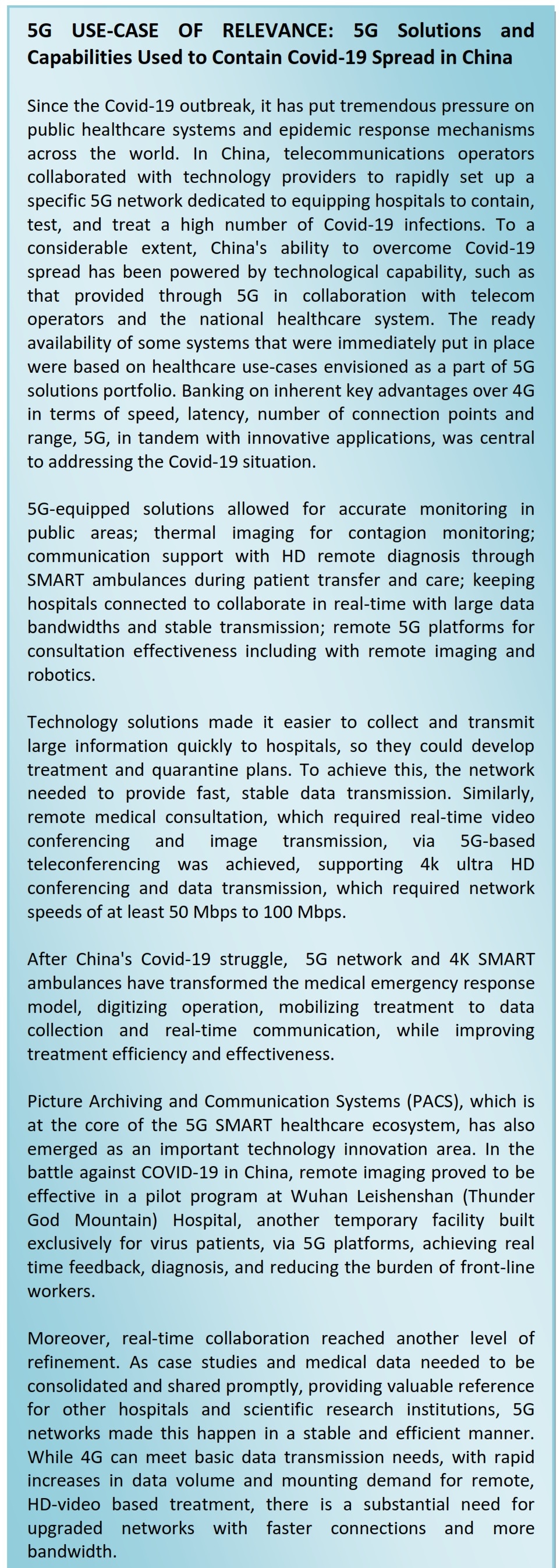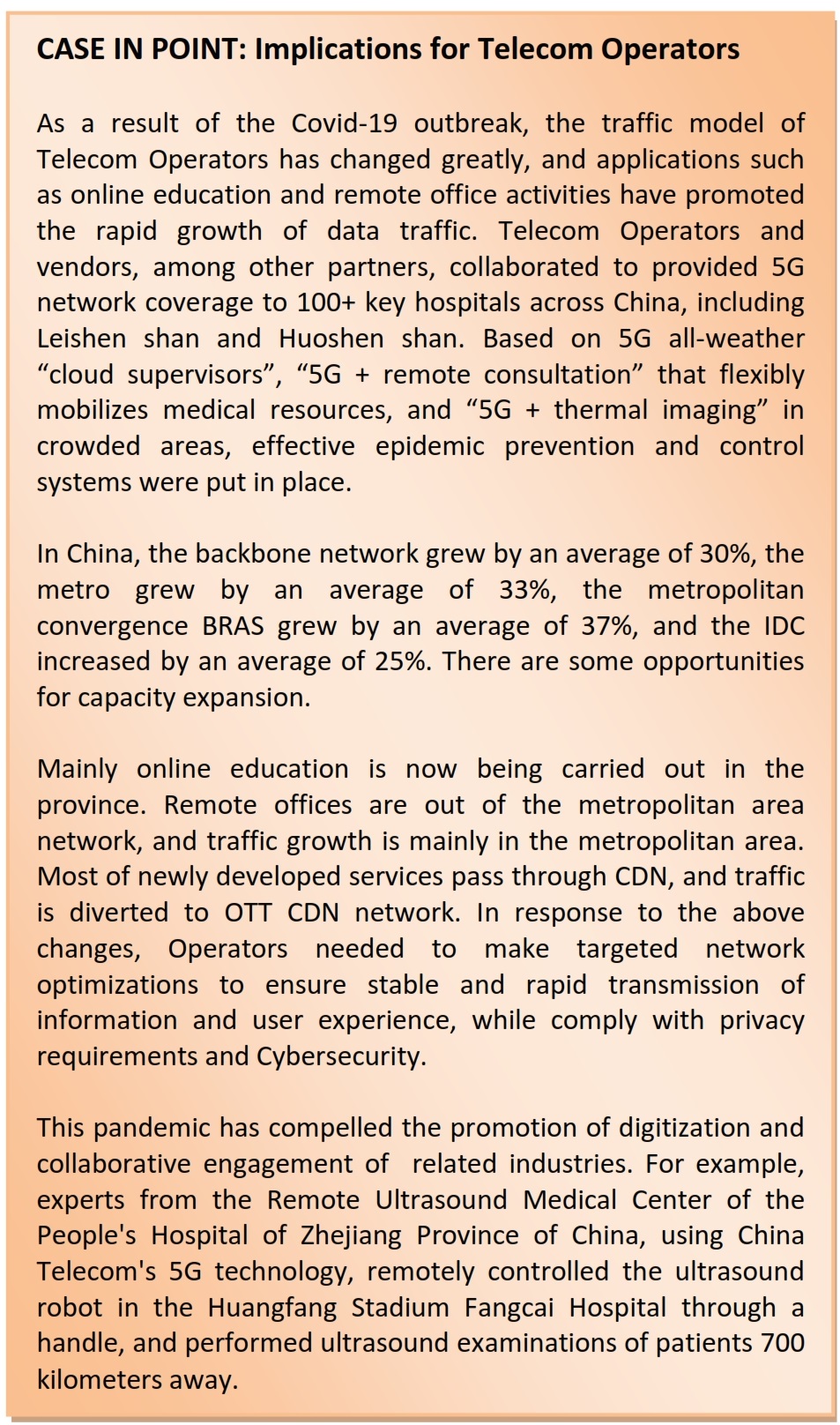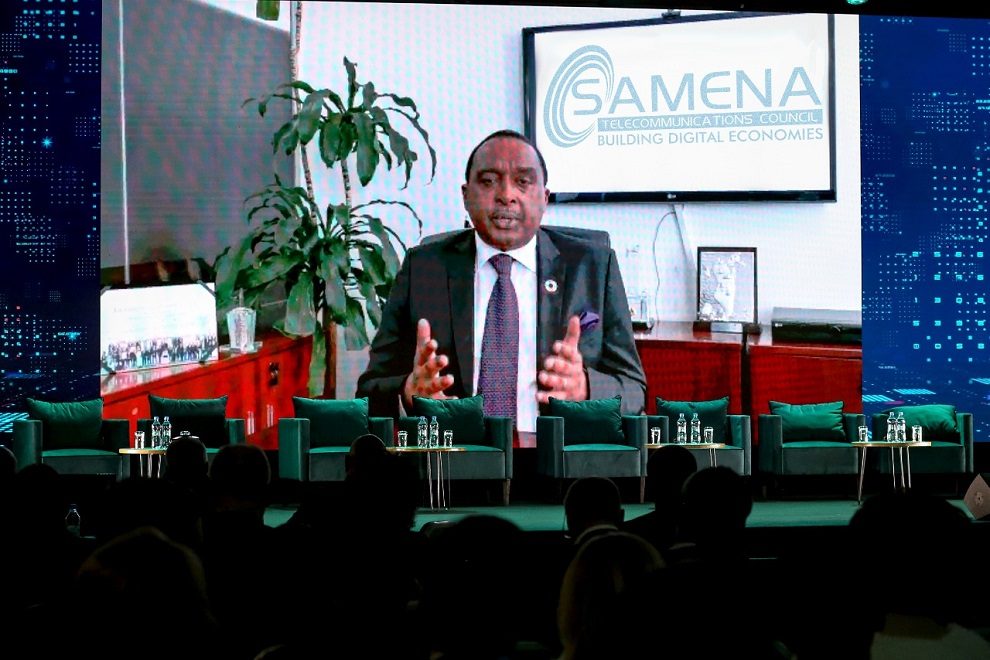Dealing with the aftermath of COVID-19 through collaborated acceleration of 5G implementation across the world
Ever since the New Year dawned upon us, a standstill prevails across our globalized human society. A few months ago, it’d have been unimaginable to think that a formidable new foe in Coronavirus SARS-CoV-2 would have the ability to put our entire worldly activities to a halt. Although COVID-19 vaccine trials have now started, and while there is yet no slowing down of the adverse impact catalyzed by COVID-19, we can be certain that the innate human potential, which has taken us from surprise-to-solution in just a few months, our humanity, and our collaborative efforts remain our best anchors in tides.
Given the role ICTs play in our lives, SAMENA Council sees several reasons for accelerating urgency in overcoming bottlenecks in both broadband connectivity as well as in 5G implementation, in order to ensure that quick technology responses to crisis situations take place at present and in the future. The enormity of the situation gone viral now demands multi-stakeholder collaboration and re-prioritization in both letter and spirit.
COVID-19′s socio-economic impact
COVID-19 has caused unprecedented ripple effects across the health sector, manufacturing industries, retail and other travel services, trade and transportation, leisure, work and play. As a result, reductions in long-term growths across markets are being predicted. Supply chains have been disturbed. Stocks have tumbled. Investment plans for physical infrastructure development, including ICT, have come under review. Social and business activities are down. Important international meetings have been cancelled. What is most critical, however, is that livelihoods have come under immense stress. Equally so, the entire world’s education system and technology capability to assist in e-learning have come under pressure to perform, especially due to fear that some students may temporarily and some may permanently loose opportunity to complete education, causing direct family-level impact on future livelihoods and national-level impact on the economy.
On the lighter and brighter side, nonetheless, COVID-19 has optimized our online experience for both business and social interactions, while bringing families together; detaching us from the many complexities of modern-day life and re-instilling in our next generation a time-tested value system, which would be essential to thriving in the hyper-connected society of tomorrow. We are also re-learning hygiene; something that we now realize would be necessary for creating a healthy, sustainable, smart-city environment.
A befitting collective response needed from the telecom & ICT industry
The Telecom/ICT is the world’s digital nervous system, fulfilling not only its connectivity and information needs, but revenue-generation as well. As a major pillar of national development and a carrier of digital innovation across industries and economic sectors, our Industry needs to deliver consolidated, collaborated responses to both current and future global crisis situations. Technological prowess, proactive readiness in making timely information available, mobile network capabilities and data analytics, accurate situational analysis, willingness to meaningfully collaborate with concerned cross-sector entities in urgency, and fostering emotional intelligence in our informationally-bombarded society are some necessary components of the responses, which the Industry and its leaders do need to demonstrate.
What has followed over the past several weeks within our Industry, including the cancellation of MWC in Barcelona, the postponement of the SAMENA Council Leaders’ Summit 2020 in Dubai, imposed quarantine of employees or forced leaves, to say the least, serve both as a food for thought as well as an impetus for strongly and wisely reacting to the prevailing and future challenges.
Lest we forget, COVID-19 has drastically slowed down our progress on the Sustainable Development Goals (SDGs). In doing so, it has identified and placed a great responsibility on the shoulders of the Telecom Industry — Telecom Operators, Internet Companies, Technology Providers, niche-se gment Digital Players, Policy-makers, and ICT Regulatory Bodies. We need to play our role in mitigating the huge social costs that the world is now incurring due to a new microscopic challenge. Given our globalization-driven world and highly interconnected and much interdependent lifestyles, pandemics of the modern era are much more powerful, speedier, and hold much larger damage footprints, both physically and psychologically.
gment Digital Players, Policy-makers, and ICT Regulatory Bodies. We need to play our role in mitigating the huge social costs that the world is now incurring due to a new microscopic challenge. Given our globalization-driven world and highly interconnected and much interdependent lifestyles, pandemics of the modern era are much more powerful, speedier, and hold much larger damage footprints, both physically and psychologically.
The UN Broadband Commission, through its Working Group on Epidemic Preparedness’s report two years ago, described how epidemics monitoring system based on fixed and mobile networks, epidemics data platform, and remote training programs aimed at enhancing public awareness toward epidemics, should be used to augment approaches for managing widespread occurrences of infectious diseases. Considering the nature of COVID-19, which has already reached more than 166 countries, proving that it will not be tackled by regionally fragmented responses, there is a strong need for us to build a set of united technology-policy-collaboration fronts at a global level to fight infectious diseases and challenges of similar scale.
In the Broadband Commission’s Working Group’s report, one of the Industry’s most promising discussion areas, “Big Data analysis”, was also emphasized on as a potential means to help prevent the spread of infectious disease with ICT. There are multiple ways, including the use of traditional Call Data Records or latest IoT generated data, through which new trends in citizen mobility and incidents of infection outbreaks can be identified in solutions that are expanding to include not only medical data from hospitals but also user-generated roaming and Social Media data as well internet search engine queries. Needless to say, any data aggregation and utilization remains in need of fulfilling cybersecurity and data protection requirements; an altogether different subject area of great breadth.
Taking the previous work done by the Broadband Commission, the ITU, and leading private sector associations and technology companies on epidemic surveillance and control, the Industry’s collective imagination — as well as availability of Artificial Intelligence, Remote Sensing, IoT, Robotics, Image Processing, Augment Reality, Virtual Reality, Cloud Computing and Communication, and of course, extremely high and efficient connectivity characteristics inherent to 5G — may help explicate how we could have contained the adverse impact of COVID-19 earlier on, while maintaining the globalization spirit and ensuring continuity in communication; preventing a sense of dismay; and thwarting economic meltdown. This is so, because 5G’s benefits extend far beyond end-user digital experience and into other existing industries as well as emerging industry segments.
Isolation vs connectivity: Fifth-generation technology response to the next-generation health challenge – Possible use case
For the Telecom Industry, given the central role that Telecom Operators have in spearheading this age of meaningful connectivity across geographical regions, our response to the COVID-19 pandemic should be equally pan-regional. Just as we established early last month during SAMENA Council’s Convergence to Bahrain 2020 conference that 5G Operators can no longer just sell connectivity but must proactively explore with vertical partners how 5G-enabled systems can be effectively leveraged beyond simple connectivity, it now merits emphasizing that 5G may have found its first, full-fledged real-life global use- case and it just may be the best technology response to SARS-CoV-2.
Whereas COVID-19 has isolated us all, ICT infrastructure has emerged among the most important reliability pillars for the society, with 5G technologies allowing for various applications to be deployed swiftly, using high bandwidths, supporting massive connections, and providing low-latency in data transmission for real-time services. Similar to how the spread of COVID-19 demands global cooperation among governments, international organizations and the private sector decision-makers, 5G too requires the same level of stakeholder engagement, urgency, decision-making momentum, overcoming regulatory, policy, and investment sustainability hurdles and, release of 5G development funds on war footings, as recently done by the World Bank Group and governments of several UN Member States to fight the new Coronovirus spread.
The country initially and most affected by COVID-19 was the first to use 5G to bring a sense of hope in a highly distressful situation. China, with its vast area, world’s largest and highly mobile population, complex socio-economic and demand and supply structure, timely put effective communication, data exchange, and all available 5G-based tools and technologies to use to deal with the health crisis. This is primarily so, because China was among the first nations to complete required policy, technology deployment and business use-case frameworks to adopt 5G last year. China has pushed for broadband (Mobile and Fiber) adoption for years, and had set clear strategic goals for 5G to boost next-generation digital infrastructure by 2025.
At the pace in which patients are being admitted to hospitals for COVID-19 all around the world, with 5G we can realize innovative medical use-cases, such as Remote Collaboration, Remote Diagnosis, Remote Protection, and new services for the public during the pandemic.
Had we realized mass-scale 5G adoption, education would not have suffered to the extent it has. 5G networks, offering bandwidth, speed, and low-latency inherent to their design, combined with advanced HD video solutions could have allowed for the delivery of remote instruction, including immersive learning experiences through virtual reality (VR). The effectiveness of engaging students for problem-solving and collaborating to seek new solutions to problems is an area of instruction that is central to proper education, and 5G is able to make this happen.
If we had 5G in place well in advance, many of the business activities, including high-priority multi-stakeholder meetings would still have taken place as 5G is the farthest we have come to realize remote collaboration and remote decision-making through communication technologies. While current audio and video conferencing and sharing technologies do allow remote professionals to participate, the essence of a meeting room lies in being able to communicate at a personal real-life level, which only 5G is able to achieve.
The plethora of information created and propagated on COVID-19 speaks volumes about the necessity of truthful and timely information, trust-building, cybersecurity, and how relevant institutions and the Industry need to address crisis situations of the future. Had 5G networks been operating, a culture of innovation would already have been catalyzed, with Telecom Operators having the ability to almost instantly launch their own specific COVID-19 mobile apps, providing accurate, real-time information in collaboration with hospitals and local community management, including on neighborhood traffic flows, nearest hospitals, smart ambulances nearby, and pertinent information which would be helpful for end-users.
If 5G was fully in place, autonomous vehicles or taxis may have made their way into the mainstream. This certainly would have helped reduce the number of taxi drivers who have been diagnosed with COVID-19 in many urban areas. 5G could have served as a much speedier mechanism for connecting medical scientists, virologists, molecular geneticists, medical providers, pathologists, and remote specialists to find cure in even more record time than it has taken to develop and trial the current COVID-19 vaccination. Granted the current search for cure is much speedier than it has ever been and while, historically, it has taken years to develop vaccines, computational capability we now have and the data transmission speeds in existence today offer a great promise of finding the solution, soon.
 With international travel and tourism having suffered significantly, and airlines having lost some anticipated windows of financial opportunities for the current year, had we had 5G fully in place today, reality-based technologies and immersive experiences would have offered the next-best substitute to cancelled trips and sight-seeing or more. Offering a fusion of net and computational power, 5G enables true immersive experiences, which require high data flows, very low delay, high reliability, and low costs.
With international travel and tourism having suffered significantly, and airlines having lost some anticipated windows of financial opportunities for the current year, had we had 5G fully in place today, reality-based technologies and immersive experiences would have offered the next-best substitute to cancelled trips and sight-seeing or more. Offering a fusion of net and computational power, 5G enables true immersive experiences, which require high data flows, very low delay, high reliability, and low costs.
Due to COVID-19, some challenges in the continuity of the leadership have also been observed. Thus some countries have announced postponement of elections. Had we had 5G capabilities fully in place, remote balloting through a fully immersive experience, with integrity and confidentiality of the voting process ensured, could have been conducted, reducing uncertainty as well as time and administrative costs in electioneering.
Had we had 5G in place, our management models for the smart-city environment would have been well on their way to being tested for actual implementation by now. That is, data aggregation, processing, and transmission capability being demonstrated by 5G in the case of healthcare sector can very well be emulated in national or regional disaster management approaches, autonomous logistics and transportation of resources, urban development and management, and environmental protection. All of these areas are important to realizing the vision of sustainable smart cities, and are equally important globally, given their close correlation with SDGs.
Developing the 5G culture and moving forward
As a source of inspiration and encouragement, at least one real field test on the 5G’s promise of large bandwidths, high speeds, and low latency in making COVID-19 diagnosis and patient care efficient and safer for the medical practitioners as well as the surroundings, has been conducted — leveraging allied technologies, such as drones for carrying medical supplies and supporting policing efforts, robots equipped with AI capability and voice prompts, temperature detection, thermal imaging, disinfectants, among other features. This clearly demonstrates that the technology tools are ready for standardized use in similar situations elsewhere.
However, the 5G approach transcends technology. What we need is a 5G culture, with all necessary mindsets, practices, capabilities, attitudes, swiftness in reaction and intervention, and a far-reaching vision for a smart, sustainable society.
Now is the time to revisit and re-energize our multi-stakeholder engagement approaches. 5G win-win scenarios now need to focus on how we can expedite 5G development rather than if we need it. Core issue areas in 5G investments remain centered on incentivization of infrastructure investments, including on spectrum and fiber deployment, and on creating relevant partnerships among terrestrial and satellite operators and other digital space players. Moreover, policy-makers and regulators should now categorically reconsider infrastructure regulations, spectrum policies, industry fees and taxation, incentives and competition policies to help accelerate 5G investments, while keeping current market sustainability needs and demands in check.
What the current COVID-19 crisis has brought to the surface is that, although after at least six long years of deliberations and speculations we may have started our journey toward 5G, we have yet not fully mastered our mindset for it. After the new Coronavirus, it is this need for cultural change that must now become viral. Clearly, no win-win technology deployment scenarios in the future will be complete without due consideration given to health management and epidemic control, among other considerations such as implementing cybersecurity and fixing security vulnerabilities in existing and future networks. COVID-19 must inspire acceleration of 5G update, and we need to develop a technology plus collaboration culture to deal with natural disasters and similar crisis situations in the future.
Therefore, as call-for-action, it is highly pertinent that industry decision-makers take immediate steps to (1) promote that ICT infrastructure is fundamental to the survivability of the nations and thus positive policies must be framed as soon as possible to incubate innovation to accelerate digital infrastructure development and transformation; (2) define clear digital blueprints, to achieve common consensus among policy-makers and ICT ecosystem players; (3) align national ICT visions with global trends and agreed ICT development objectives, by formulating clear telecommunications industry plans and corresponding digitization promotion policies, which should also help enhance competitiveness within the telecommunications industry; (4) encourage 5G+ industry applications to develop a full-fledged 5G ecosystem, by ensuring that platforms and facilities are provided to newcomers and that market-entry barrier are reduced for new investors; and (5) identify and foster ICT talent, and put in practice talent management approaches.
About the Author
Bocar BA is CEO & Board Member of SAMENA Telecommunications Council. He participates in leading platforms and global telecommunications development institutions, including the ITU, UN Broadband Commission, and World Economic Forum (WEF) Global Future Council, among others, as a representative of Telecom Operators and private sector, at large. He advocates on the need for effective policy-making and next-generation regulation.
Contributors
This thought piece draws inspiration from insights provided by the TRA-UAE.
Izhar Ahmad, Director – Industry Affairs & Communication, SAMENA Council, contributed from conception to publication. He is member of Eta Kappa Nu.












